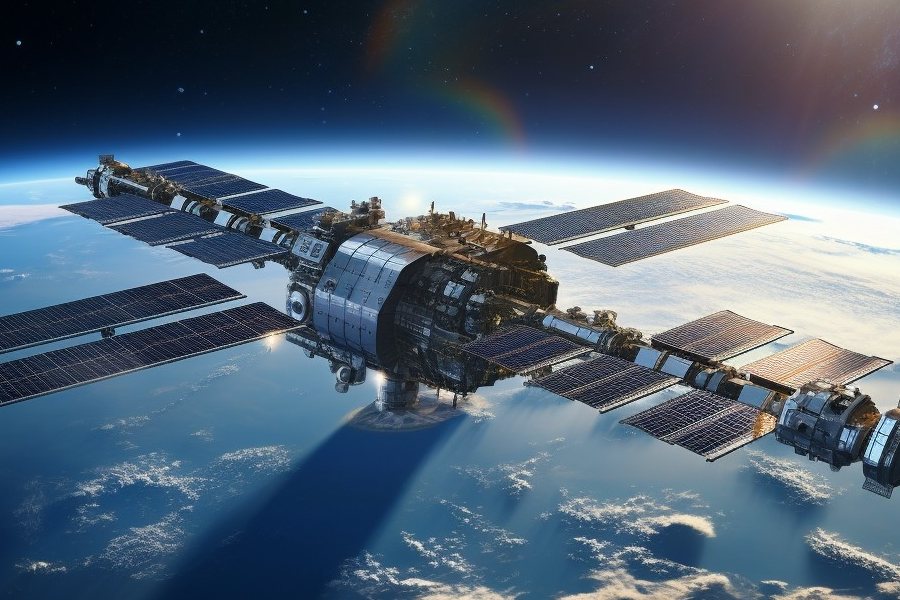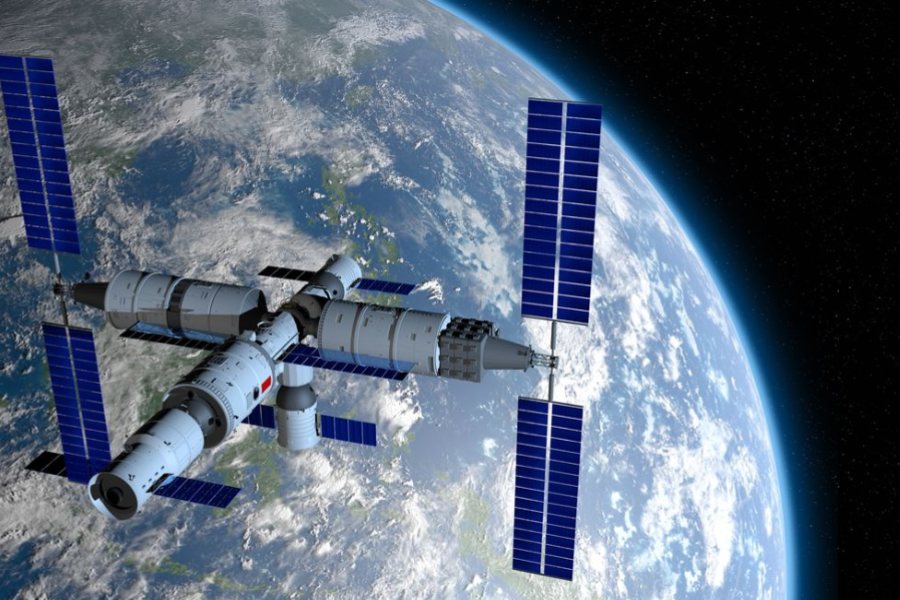Embarking on a celestial journey, one cannot help but marvel at the sheer ingenuity of humanity’s efforts to extend its presence beyond Earth. As we gaze into the cosmos, curiosity leads us to ponder a fundamental question: how many space stations are there?
The International Space Station comes to mind first when considering human outposts in space. Yet the ISS is hardly alone up there. Numerous other orbital outposts, some meeting unfortunate fates, have come before it.
Today, several countries plan to launch space stations in the coming years as access to space becomes more affordable. So, join us on this cosmic odyssey as we delve into the current count of space stations, showcasing the collaborative achievements that propel us into outer space.

How Many Space Stations Are There?
As of 2023, two active space stations are in low Earth orbit. The first, the International Space Station (ISS), is a collaborative effort involving NASA, Roscosmos, ESA, JAXA, and CSA. Since its inception in 2000, the ISS has remained continuously inhabited, serving as a hub for global scientific research, technology development, and international cooperation.
On the other hand, China’s Tiangong Space Station (TSS) is a pivotal component of the Tiangong program. Launched in modular components in 2011, the TSS focuses on scientific experiments, Earth observation, and technology testing. This initiative underscores China’s dedication to space exploration and its eagerness to engage in international collaborations within the scientific community.
The ISS and TSS are indispensable in advancing humanity’s comprehension of space. Beyond their contributions, both stations catalyze global partnerships in scientific endeavors, emphasizing the importance of cooperation in exploring outer space.
Current Operational Space Stations
International Space Station (ISS)
The International Space Station (ISS) construction commenced in 1998 as a collaborative effort involving the U.S., Russia, Europe, Japan, and Canada space agencies. Over 13 years, the orbital construction process unfolded, resulting in a sophisticated structure comprising pressurized modules, solar arrays, etc.
Functioning as a microgravity laboratory, the ISS is dedicated to conducting research across various scientific fields. It serves as a testing ground for new technologies designed for extended spaceflight, exemplifying peaceful cooperation among nations in space exploration.
Since its inception in 2000, the ISS has been continuously occupied by international crews tirelessly conducting experiments around the clock. Regular deliveries of supplies and additional modules are facilitated through visiting spacecraft.
Notably, the station has received approval for operational continuation through 2030. This solidifies its ongoing contribution to scientific discovery and international collaboration in space.
China’s Tiangong Space Station (TSS)
Upon completion, the Tiangong Space Station (TSS) will boast a total mass of approximately 66 metric tons. The construction began with the launch of the core module, Tianhe, in 2021, followed by the addition of two labs, Wentian and Mengtian. Further expansion is anticipated, with the possibility of launching additional parts.
The overarching goals of the TSS encompass space science research and technology testing, emphasizing areas such as astronomy, biotech, microgravity physics, and space medicine. China envisions operating the TSS for at least 10 years as a platform for advanced research and experimentation.
The TSS significantly elevates China’s capabilities in human spaceflight and space research. With the potential to host foreign astronauts, it holds the promise of fostering positive international relationships for the peaceful advancement of space exploration. This collaborative approach could pave the way for shared scientific endeavors and cooperation in space exploration.

Historical Space Stations: How Many Space Stations Have There Been?
Mir – Russia’s long-duration space station
Mir was a space station operated by the USSR and later Russia. It orbited Earth from 1986 to 2001. The station served as an important research laboratory.
Numerous crews inhabited it over its 15-year lifespan. Mir set records for continuous human presence in space. It paved the way for future stations.
Skylab – America’s first space station
Launched by NASA in 1973, Skylab marked the United States’ inaugural venture into space station development. Skylab was crucial in advancing scientific research throughout its six-year operation until reentering the Earth’s atmosphere in 1979.
The station facilitated investigations across diverse disciplines such as solar science, Earth observations, biology, and physics. One of Skylab’s notable contributions was acquiring key data on the impacts of long-duration human spaceflight, offering valuable insights for future missions.
Skylab, alongside the Mir space station, exemplified early capabilities in constructing and utilizing orbital research platforms. Despite their decommissioning, the knowledge gained from these pioneering space stations continues to shape and enhance human spaceflight programs globally.
Today, the legacy of Skylab and Mir persists in the ongoing operations of the International Space Station (ISS), which serves as a testament to their foundational contributions. The wealth of information from these early endeavors remains integral to advancing our understanding of space and fostering advancements in space exploration.
Other Space Station Projects
How many countries have space stations? So far, the United States, Russia, China, and a consortium of nations that own the International Space Station have all operated space stations.
Russian Orbital Segment (ROS) and proposed successor stations
Russia plans to detach some of its current modules from the ISS eventually. These detached modules may be used to form an independent Russian Orbital Segment for operations.
Russia has also proposed developing a next-generation space station to launch in the late 2020s. This future Russian station could host missions to the Moon or Mars, acting as a deep space gateway.
Planned modules or stations by private companies for research or commercial purposes
Numerous private aerospace companies, including Bigelow Aerospace, Sierra Nevada Corporation, and Axiom Space, have developed modules and outposts for private space stations. The primary objective of some of these commercial modules is to initially connect to the existing International Space Station (ISS) for early operations, with plans to function as free-flying orbital stations eventually.
Meanwhile, other modules are conceived to operate independently from the outset. They serve as standalone commercial facilities in Earth’s orbit.
International collaborations or future space station concepts
In 2022, the Chinese Tiangong Space Station opened for collaboration with foreign nations. Additionally, India had conceptualized the development of its modular space station with capabilities for microgravity experiments.
Such multinational cooperation on potential future stations aims to boost innovation mutually. All participating nations could benefit by sharing economic development costs and technical infrastructure in space across partners.
Proliferation of space stations
The increasing proliferation of space stations opens up new avenues for diverse scientific pursuits in Earth orbit. Multiple global players are now capable of independently constructing advanced orbital outposts.
New possibilities are emerging to test revolutionary technologies, enable innovative space-based businesses, and gain invaluable knowledge to push further boundaries into the space frontier. The future looks promising for a thriving ecosystem of orbital stations supporting critical research that expands humanity’s reach beyond our home planet.
Conclusion
How many space stations are there? There are currently two major operational space stations in Earth’s orbit – the pioneering ISS that has continued providing crucial support for human space exploration goals and China’s Tiangong station, which signifies the nation’s technological advancement.
In addition to the existing plans, there is a growing momentum in developing commercial space stations and collaborative projects on the horizon. The upcoming years are poised to witness a flourishing ecosystem of orbital outposts.
These stations will facilitate crucial microgravity research and play a pivotal role in expanding economic activities in low Earth orbit. With numerous stations to support these endeavors, the future appears exceptionally promising for humanity’s space exploration ambitions.
